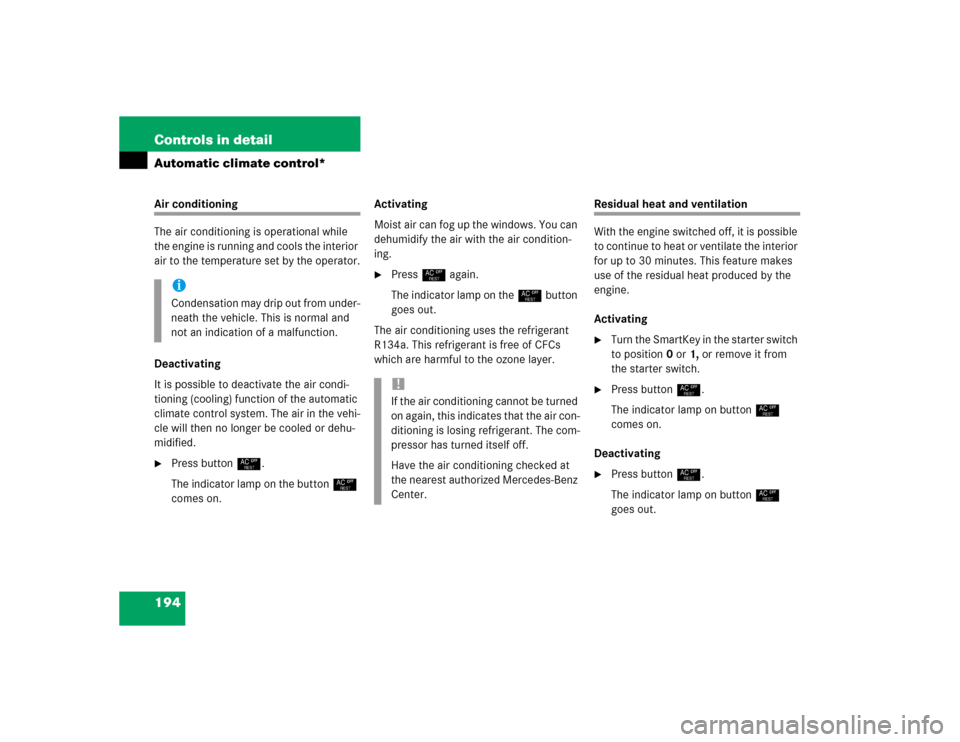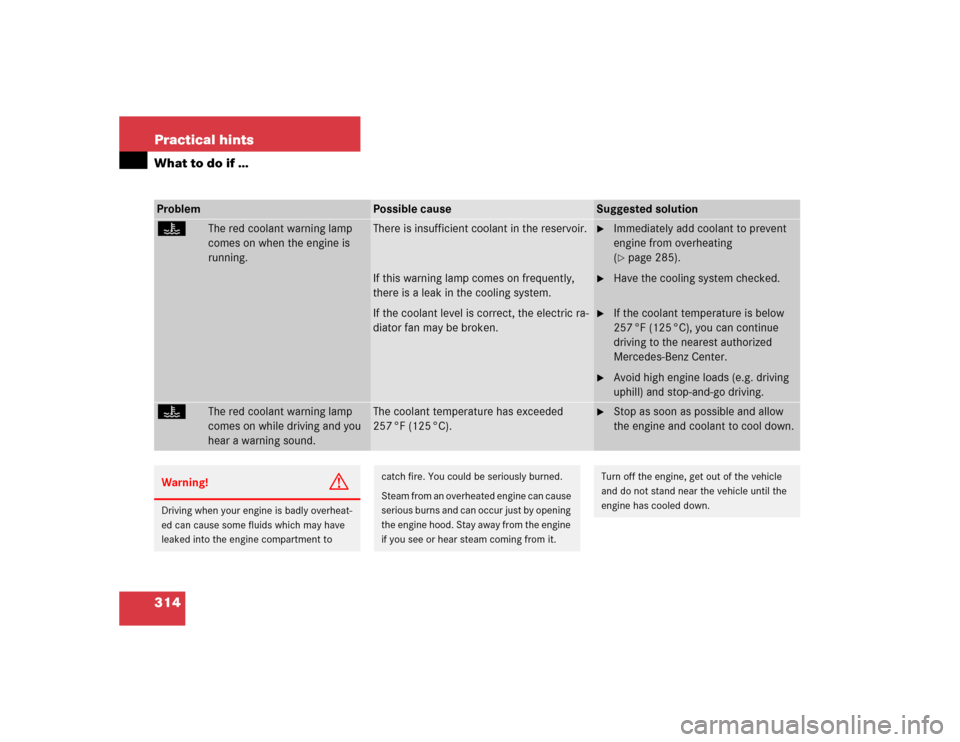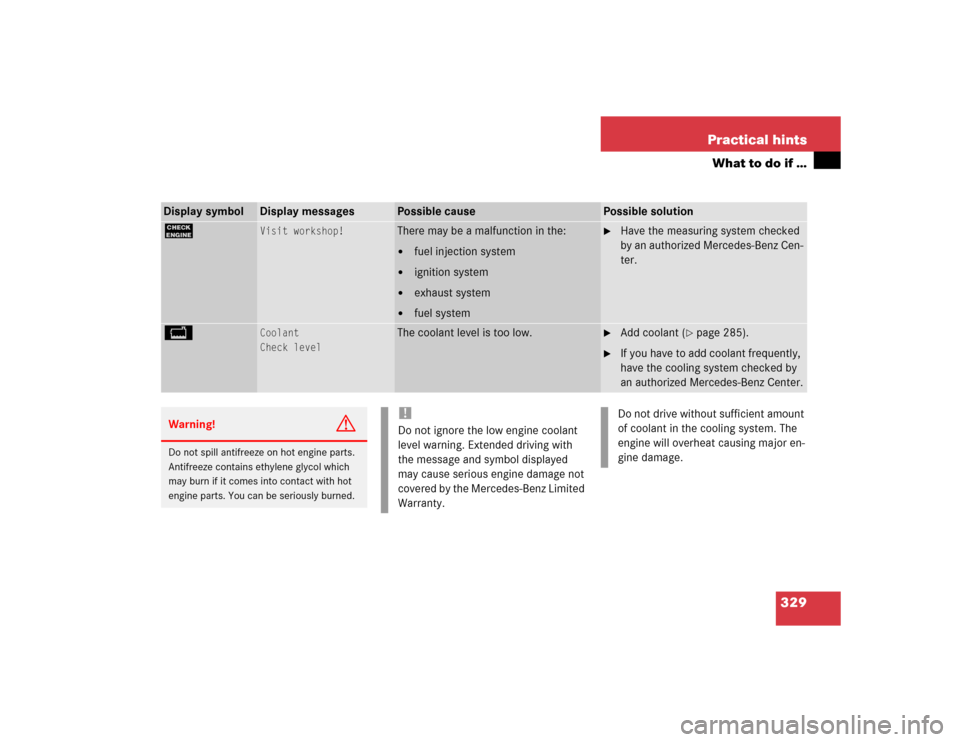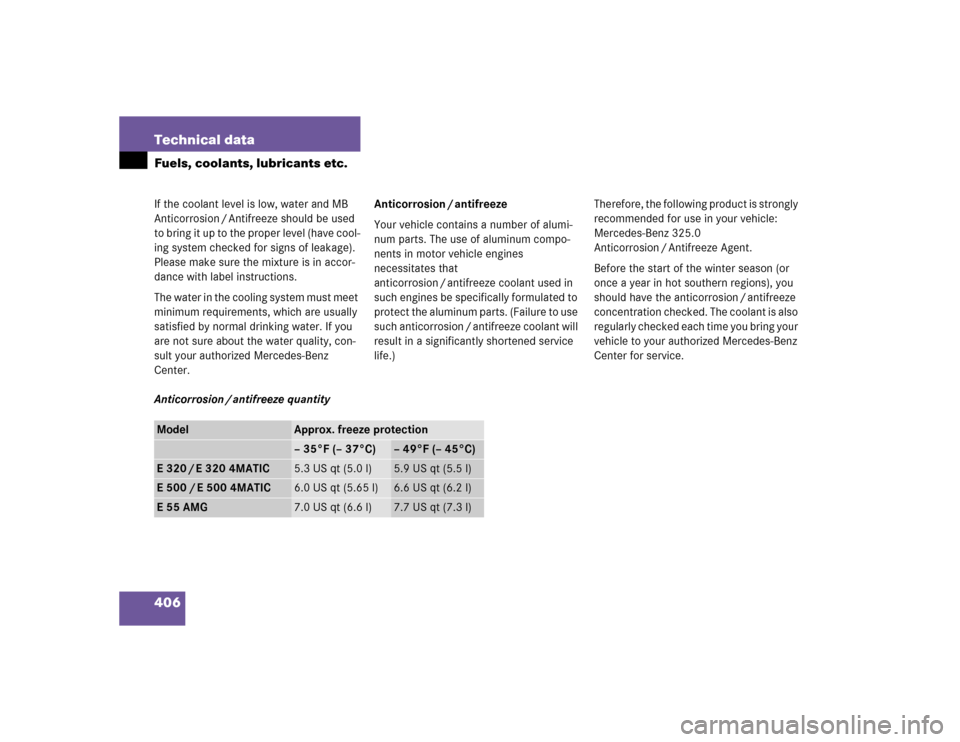Page 194 of 442

194 Controls in detailAutomatic climate control*Air conditioning
The air conditioning is operational while
the engine is running and cools the interior
air to the temperature set by the operator.
Deactivating
It is possible to deactivate the air condi-
tioning (cooling) function of the automatic
climate control system. The air in the vehi-
cle will then no longer be cooled or dehu-
midified.�
Press button°.
The indicator lamp on the button°
comes on.Activating
Moist air can fog up the windows. You can
dehumidify the air with the air condition-
ing.
�
Press° again.
The indicator lamp on the°button
goes out.
The air conditioning uses the refrigerant
R134a. This refrigerant is free of CFCs
which are harmful to the ozone layer.
Residual heat and ventilation
With the engine switched off, it is possible
to continue to heat or ventilate the interior
for up to 30 minutes. This feature makes
use of the residual heat produced by the
engine.
Activating�
Turn the SmartKey in the starter switch
to position0 or1, or remove it from
the starter switch.
�
Press button°.
The indicator lamp on button°
comes on.
Deactivating
�
Press button°.
The indicator lamp on button°
goes out.
iCondensation may drip out from under-
neath the vehicle. This is normal and
not an indication of a malfunction.
!If the air conditioning cannot be turned
on again, this indicates that the air con-
ditioning is losing refrigerant. The com-
pressor has turned itself off.
Have the air conditioning checked at
the nearest authorized Mercedes-Benz
Center.
Page 286 of 442

286 OperationEngine compartment
1Coolant expansion tank�
Using a rag, turn the cap slowly approx-
imately one half turn to the left to re-
lease any excess pressure.
�
Continue turning the cap to the left and
remove it.The coolant level is correct if the level:
�
for cold coolant: reaches the black
top part of the reservoir
�
for warm coolant: is approximately
0.6 in (1.5 cm) higher
�
Add coolant as required.
�
Replace and tighten cap.
More information on coolant can be found
in the “Technical data” section
(
�page 405).
Warning!
G
In order to avoid any possibly serious burns:�
Use extreme caution when opening the
hood if there are any signs of steam or
coolant leaking from the cooling system,
or if the coolant temperature gauge indi-
cates that the coolant is overheated.
�
Do not remove pressure cap on coolant
reservoir if engine temperature is above
194°F (90°C). Allow engine to cool
down before removing cap. The coolant
reservoir contains hot fluid and is under
pressure.
�
Using a rag, slowly open the cap approx-
imately
1/2 turn to relieve excess pres-
sure. If opened immediately, scalding
hot fluid and steam will be blown out un-
der pressure.
�
Do not spill antifreeze on hot engine
parts. Antifreeze contains ethylene gly-
col which may burn if it comes into con-
tact with hot engine parts.
Page 314 of 442

314 Practical hintsWhat to do if …Problem
Possible cause
Suggested solution
D
The red coolant warning lamp
comes on when the engine is
running.
There is insufficient coolant in the reservoir.
If this warning lamp comes on frequently,
there is a leak in the cooling system.
If the coolant level is correct, the electric ra-
diator fan may be broken.
�
Immediately add coolant to prevent
engine from overheating
(�page 285).
�
Have the cooling system checked.
�
If the coolant temperature is below
257 °F (125 °C), you can continue
driving to the nearest authorized
Mercedes-Benz Center.
�
Avoid high engine loads (e.g. driving
uphill) and stop-and-go driving.
D
The red coolant warning lamp
comes on while driving and you
hear a warning sound.
The coolant temperature has exceeded
257 °F (125 °C).
�
Stop as soon as possible and allow
the engine and coolant to cool down.
Warning!
G
Driving when your engine is badly overheat-
ed can cause some fluids which may have
leaked into the engine compartment to
catch fire. You could be seriously burned.
Steam from an overheated engine can cause
serious burns and can occur just by opening
the engine hood. Stay away from the engine
if you see or hear steam coming from it.
Turn off the engine, get out of the vehicle
and do not stand near the vehicle until the
engine has cooled down.
Page 329 of 442

329 Practical hints
What to do if …
Display symbol
Display messages
Possible cause
Possible solution
?
Visit workshop!
There may be a malfunction in the:�
fuel injection system
�
ignition system
�
exhaust system
�
fuel system
�
Have the measuring system checked
by an authorized Mercedes-Benz Cen-
ter.
B
Coolant
Check level
The coolant level is too low.
�
Add coolant (
�page 285).
�
If you have to add coolant frequently,
have the cooling system checked by
an authorized Mercedes-Benz Center.
Warning!
G
Do not spill antifreeze on hot engine parts.
Antifreeze contains ethylene glycol which
may burn if it comes into contact with hot
engine parts. You can be seriously burned.
!Do not ignore the low engine coolant
level warning. Extended driving with
the message and symbol displayed
may cause serious engine damage not
covered by the Mercedes-Benz Limited
Warranty.
Do not drive without sufficient amount
of coolant in the cooling system. The
engine will overheat causing major en-
gine damage.
Page 331 of 442
331 Practical hints
What to do if …
Display symbol
Display messages
Possible cause
Possible solution
Ï
Coolant
Stop, engine off!
The poly-V-belt could be broken.
�
Stop immediately and check the
poly-V-belt.
If it is broken:
�
Do not continue to drive. Otherwise
the engine will overheat due to an in-
operative water pump which may re-
sult in damage to the engine. Notify
an authorized Mercedes-Benz Center.
If it is intact:
�
Do not continue to drive the vehicle
with this message displayed. Doing so
could result in serious engine damage
that is not covered by the
Mercedes-Benz Warranty.
Coolant
Visit workshop!
The cooling fan for the coolant is malfunc-
tioning.
�
Observe the coolant temperature dis-
play.
�
Have the fan replaced as soon as pos-
sible.
Page 401 of 442
401 Technical data
Fuels, coolants, lubricants etc.
Model
Capacity
Fuels, coolants, lubricants etc.
Power steering
approx. 1.1 US qt (1 l)
MB Power Steering Fluid (Pentosin CHF 11S)
Front wheel hubs
approx. 3.0 oz (85 g) each
High temperature roller bearing grease
Brake system
1.1 US qt (1.05 l)
MB Brake Fluid (DOT 4+)
Cooling system
E320 / E3204MATIC
10.7 US qt (10 l)
MB 325.0 Anticorrosion / Antifreeze
E500 / E5004MATIC
11.9 US qt (11.3 l)
E55AMG
13.8 US qt (13.2 l)
Fuel tank
including a reserve of
21.12 US gal (80.0 l)
2.38 US gal (9.0 l)
Premium unleaded gasoline:
Posted Octane 91 (Avg. of 96 RON / 86 MON)
Page 405 of 442

405 Technical data
Fuels, coolants, lubricants etc.
Damage or malfunctions resulting from
poor fuel quality or from blending specific
fuel additives are not covered by the
Mercedes-Benz Limited Warranty.Coolants
The engine coolant is a mixture of water
and anticorrosion / antifreeze, which pro-
vides:�
Corrosion protection
�
Freeze protection
�
Boiling protection (by increasing the
boiling point)
The cooling system was filled at the factory
with a coolant providing freeze protection
to approximately -22°F (-30°C) and corro-
sion protection.If the antifreeze mixture is effective to
-22°F (-30°C), the boiling point of the cool-
ant in the pressurized cooling system is
reached at approximately 266°F (130°C).
The coolant solution must be used
year-round to provide the necessary corro-
sion protection and increase boil-over pro-
tection. Refer to Service Booklet for
replacement interval
Coolant system design and coolant used
stipulate the replacement interval. The re-
placement interval published in the Ser-
vice Booklet is only applicable if MB 325.0
anticorrosion/antifreeze solution or other
Mercedes-Benz approved products of
equal specification (see Factory Approved
Service Products pamphlet) are used to re-
new the coolant concentration or bring it
back up to the proper level. To provide important corrosion protection,
the solution must be at least 45%
anticorrosion / antifreeze [equivalent to
freeze protection to approximately - 22°F
(-30°C)]. If you use a solution that is more
than 55% anticorrosion / antifreeze [freeze
protection to approximately - 49°F
(-45°C)], the engine temperature will in-
crease due to the lower heat transfer capa-
bility of the solution. Therefore, do not use
more than this amount of
anticorrosion / antifreeze.
Page 406 of 442

406 Technical dataFuels, coolants, lubricants etc.If the coolant level is low, water and MB
Anticorrosion / Antifreeze should be used
to bring it up to the proper level (have cool-
ing system checked for signs of leakage).
Please make sure the mixture is in accor-
dance with label instructions.
The water in the cooling system must meet
minimum requirements, which are usually
satisfied by normal drinking water. If you
are not sure about the water quality, con-
sult your authorized Mercedes-Benz
Center.Anticorrosion / antifreeze
Your vehicle contains a number of alumi-
num parts. The use of aluminum compo-
nents in motor vehicle engines
necessitates that
anticorrosion / antifreeze coolant used in
such engines be specifically formulated to
protect the aluminum parts. (Failure to use
such anticorrosion / antifreeze coolant will
result in a significantly shortened service
life.)Therefore, the following product is strongly
recommended for use in your vehicle:
Mercedes-Benz 325.0
Anticorrosion / Antifreeze Agent.
Before the start of the winter season (or
once a year in hot southern regions), you
should have the anticorrosion / antifreeze
concentration checked. The coolant is also
regularly checked each time you bring your
vehicle to your authorized Mercedes-Benz
Center for service.
Anticorrosion / antifreeze quantityModel
Approx. freeze protection– 35°F (– 37°C)
– 49°F (– 45°C)
E320/E3204MATIC
5.3 US qt (5.0 l)
5.9 US qt (5.5 l)
E500/E5004MATIC
6.0 US qt (5.65 l)
6.6 US qt (6.2 l)
E55AMG
7.0 US qt (6.6 l)
7.7 US qt (7.3 l)